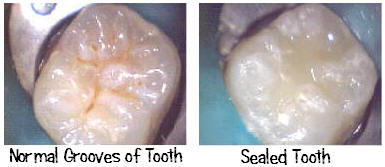What are sealants?

A sealant is a white or sometimes clear material that is placed on the chewing surfaces of your child's back teeth. Sealants protect your child's teeth from decay by acting as a physical barrier and protecting enamel from plaque and acids. The purpose of the sealant is to smooth out the normal ridges and crevices of your child's back teeth where the plaque and bacteria accumulate.
As teeth develop, grooves and ridges form on the chewing surfaces of a tooth. Food and bacteria collect in these grooves and cause decay. Sealants fill up these grooves and allow food to slide off the tooth surface. Combined with fluoridated water and topical fluorides (mouth rinses & tooth-paste), sealants virtually eliminate decay on the chewing surfaces of your child's teeth. The American Dental Association’s latest studies indicate that children who have had sealants applied to their teeth had a 6% cavity rate on the chewing surfaces of these teeth. Those children without sealants had a 59% cavity rate.
Sealants are an excellent way of protecting the chewing surfaces of your child's teeth that have never had a filling and do not have decay.
To apply a sealant, the operator cleans each tooth and then etches it with a mild acid wash to give the sealant a rougher enamel surface to cling on to. The plastic coating is then applied and cured with a special light. Excess sealant is purposely put on the tooth, and the sealant may feel high for a day or so until the sealant is shaped by the opposing tooth.
No “shots” are needed when sealants are placed on your child's tooth. Kids appreciate this!
Sealants are not a guarantee against decay. Sealants can only prevent decay on the chewing surface of your child's tooth, not in the area between the teeth. Sealants protect the chewing surfaces of your child's back molars where decay occurs most often. Your child still needs to brush every day and floss between his/her teeth. How long a sealant will last on a tooth depends on your child’s chewing, eating, and grinding habits.
Replacement of your child's sealants may be needed after three to five years as the borders of the sealant may be weakened by this time. Regular six month check-ups are needed to evaluate the condition of the sealants and to evaluate if reapplication is needed.
Sometimes as we attempt to place a sealant on a tooth, we find that there is a small amount of decay in the grooves that is not visible until we expand the opening of the groove. If this is the case, we will then need to place a small, conservative mini-resin (flowable composite) that is almost invisible. This will probably mean a slight change in any Financial Arrangements that may have been made. We do consider these as true cavities.
Sealants and mini-resins are designed to prevent decay.
For both the sealant or the flowable composite (mini-resin placement), the "tooth whistler" is used to explore the deep pits, fissures, and grooves of your child's affected teeth and to expand or open up the top of grooves, fissures, and pits (or to remove decay) in these areas. This usually is a painless procedure for your child as only a very minimal amount of tooth structure is removed. Some children will report a temporary cold sensation when the tooth whistler is used by one of our Doctors.















